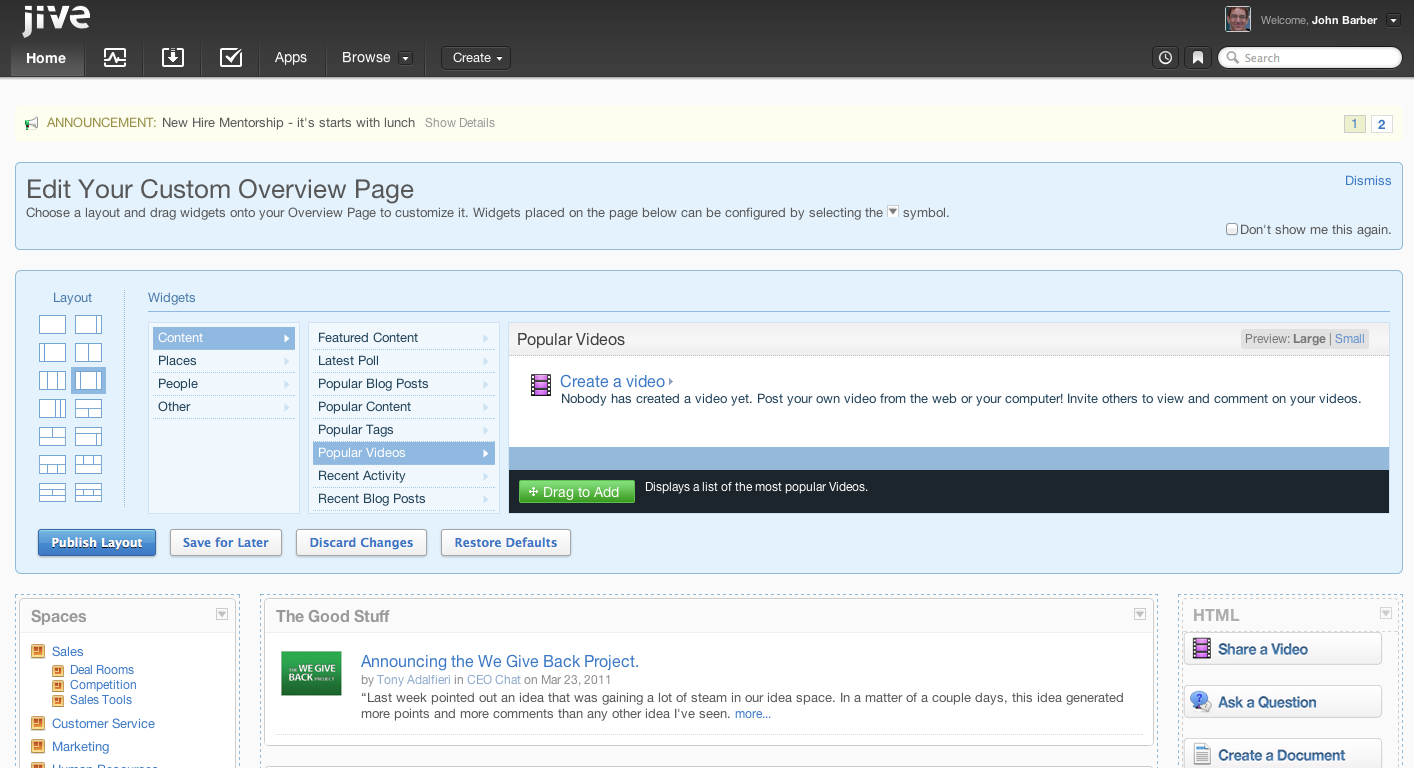Share
As an enterprise platform inherently designed to be social, Jive both competes with Igloo Software highlighted in Part 1 of our series, and also interestingly both differs from SharePoint (which will be highlighted in part 3 of our series.
Interestingly, Jive competes with SharePoint, and also integrates with SharePoint. SharePoint was originally designed with document management in mind, and focuses heavily on all aspects of document management, such as versioning, version controls, and deep functionality on rules and permissions on sharing and collaboration around documents. Jive, on the other hand, was designed first and foremost as an enterprise level social networking platform.
Jive has the ability to drag and drop widgets onto your home page, or divisional and department work spaces, to customize layouts, and add in the information you feel is important to you and your team.

The differences it its social networking capabilities, is very apparent with the evolution of Jive Anywhere, whereby your intranet access can “follow you” in the top right corner of your browser while you are surfing the intranet, so you can flow in and out of your intranet at the click of a button.

Stream Once, allows you to bring in feeds and updates from all sorts of different applications into one place - you can choose to drop these feeds into your Jive inbox, Jive group or workspace.

Unlike Igloo Software, Jive provides both on-premise and cloud based versions. The cloud version of Jive develops new features at a very fast pace. Jive offers on-premise solutions, however, if you choose the on-premise solution, you will not get all of the benefits of the cloud product releases. The on-premise application will require heavy customizations from a technology team who both understands the complexities of the user interface design needs, and has an inherent understanding of the platform. This technology team can keep pace with the cloud developments and implement custom solutions for you, to align with the cloud version of the Jive Software platform.
SharePoint does not even rank on Forrester's earlier rankings in the 2013 Social Enterprise software, which is indicative of its strong roots in document and data management, rather than social networking for real-time, online collaboration. This is why Jive has evolved a solution to integrate with Microsoft SharePoint. It cannot beat SharePoint on its deep document management capabilities. With Jive, you don’t have to choose between the business applications you depend on and the social features you need. Jive for Microsoft brings the speed, power and connectedness of Social Business to SharePoint, Microsoft Office and Microsoft Outlook. Share, collaborate and participate in your Jive community – all from your familiar Microsoft apps. The level of integration with Microsoft, simply reinforce the Jive platform, as a great enterprise level solution.
Strengths
Internal & team collaboration, social networking features, and feature rich sharing functionality, in a newer, modern, platform designed specifically for socially connected collaboration.
Weaknesses
1. Calendaring solution is not well developed. Creating and sharing a global calendar for an entire company is an impossibility. The platform does allow you to have calendars within projects for working teams.
2. With respect to document and data management, there are some limitations with creating working group lists, so documents can be easily shared to specific groups of team members, staff or employees - share lists have to be manually entered each time.
3. Cloud features and on-premise solutions are not in sync and many cloud based applications or features are not readily available in the on-premise solution.
4. If you choose an on-premise solution, Jive does not focus its technology road map on the on-premise installations, and any on-premise solution will require customizations and support ongoing to keep pace with the cloud based options and new feature releases.
5. Document management has limitations in online editing and therefore may require integration with SharePoint for those enterprises with deep document management requirements and functionality.
6. Keep customizations to a minimum if you don’t want to have to track back or lose work. The platform, as it is designed more for the enterprise, is a bit more rigid and inflexible at times, for heavier customizations. If you do choose to heavily customize, which can ultimately provide your team, staff and partners with a better experience, you’ll need a process to track the system files you update. Tracking customizations will allow you to have a well planned upgrade path to the newest version of the platform, once Jive releases it latest upgrade. You don’t want lose all your hard work and customizations.
Mad Tips: If you can partner with a Marketing Technology provider who understands the Jive platform, you can reduce your consulting and support fees considerably. Jive technical support, engagement and consulting fees can range from $250 - $350 USD in their direct service level agreements and contracts. Jive is continuously upgrading its platform, as it does effectively service the enterprise level market, and the technology roadmap and new features are constantly evolving.
Part three of the Social Intranet Series introduces Sharepoint.


